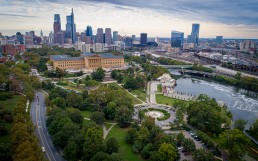Museums & Galleries

As society begins to update how they record and share their cultural heritage, museums and learning institutions are taking advantage of technologies that increase accessibility to their collections. Granting people access to exhibits and resources through digital portals makes sense in the best of times, but it becomes an absolute necessity during the time of Covid-19 and social distancing. Below are just a few ways that Terry has helped museums, galleries & learning institutions.
Services Include:
Virtual Tours are another great way to document a site. While Site Scans capture the site in 3D, Virtual Tours capture the site in full 360 from multiple locations and allow you to jump from one location to the next and have a virtual look around in any possible direction. Virtual Tours work on all major viewing platforms including mobile devices, desktops and VR Headsets such as the Oculus Quest. The VR experience is fully immersive and allows viewers to feel as if they are on site in person. The 360 panoramic photography can be captured both from the aerial and ground based perspectives and are of extremely high resolution, allowing for an incredible level of zoom to see the details of your site. Learn More.
Object scanning applies the same principle technology behind site scanning, photogrammetry, to objects on a much smaller scale. Handheld objects such as artifacts, sculptures and carvings are often scanned and cataloged digitally in an effort to share with a wider audience. Once scanned, those objects can be viewed across all major viewing platforms including mobile, desktop browser, VR headsets and AR apps. Learn More.
Cinematography and drones go hand in hand, there is no denying it. The ability to move a camera in never before possible ways has sparked a revolution of creativity across the filmmaking world over the last several years. This technology has found itself at home equally from Hollywood film sets to small scale construction sites. The ability to pull out wide and reveal vast portions of land while also being able to fly in tight for a close up on just the right detail make drones a wise tool for virtually all video production projects. Multi-person teams with dedicated pilot, camera operator and production assistant are available as well as a simple one person pilot filming, depending on project type, budget and camera/lens requirements. Learn More.
Time Lapse Photography has been a passion of Mr Kilby’s for some time and one he works into projects any chance he gets. Motion controlled time lapse in particular including sliders, turntables and drones are at the front of his interests. Time Lapses are great for capturing environment and activity alike, depending on the project. They have been used to document everything from long creative processes such as painting or sculpting to the stars of the night sky racing around the north star. Learn More.
Bespoke Software Development is often used for large projects that have specific data presentation requirements that simply aren’t met by any of the solutions available on the market today. Multiple data types can be displayed together, in one neat sandbox rather than linking out to several different viewers or platforms. Orthomosaic maps can merge with 360 panos as well as 3D scans and additional client data like CAD drawings and master plans to form one cohesive experience. Platforms include web, mobile and VR/AR. Learn More.
3D Printing extends the digital into the real world by producing a scaled, physical model of your digital files. Objects typically printed range from original 3D CAD files to scans of entire sites or small objects. Prints can range in size from just a few inches to a meter or more and come in one color filament or full color sandstone. Learn More.
